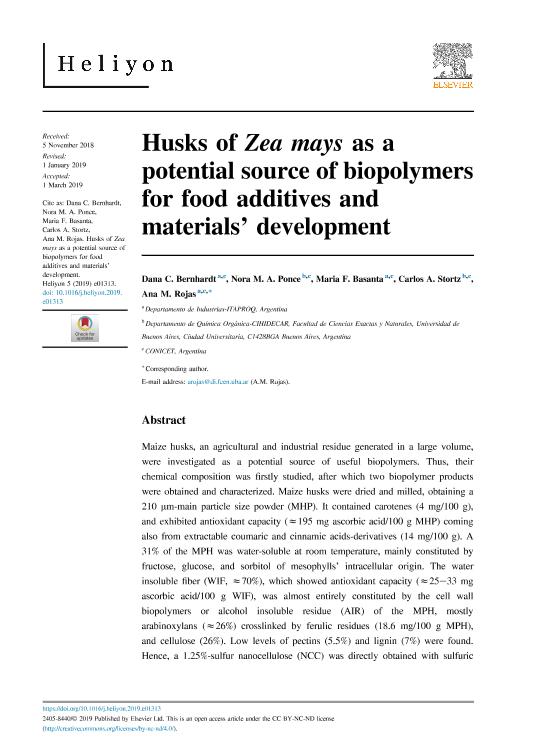Artículo
Husks of Zea mays as a potential source of biopolymers for food additives and materials? development.
Bernhardt, Dana Cecilia ; Ponce, Nora Marta Andrea
; Ponce, Nora Marta Andrea ; Basanta, Maria Florencia
; Basanta, Maria Florencia ; Stortz, Carlos Arturo
; Stortz, Carlos Arturo ; Rojas, Ana Maria Luisa
; Rojas, Ana Maria Luisa
 ; Ponce, Nora Marta Andrea
; Ponce, Nora Marta Andrea ; Basanta, Maria Florencia
; Basanta, Maria Florencia ; Stortz, Carlos Arturo
; Stortz, Carlos Arturo ; Rojas, Ana Maria Luisa
; Rojas, Ana Maria Luisa
Fecha de publicación:
02/2019
Editorial:
Elsevier
Revista:
Heliyon
ISSN:
2405-8440
Idioma:
Inglés
Tipo de recurso:
Artículo publicado
Clasificación temática:
Resumen
Maize husks, an agricultural and industrial residue generated in a large volume,were investigated as a potential source of useful biopolymers. Thus, theirchemical composition was firstly studied, after which two biopolymer productswere obtained and characterized. Maize husks were dried and milled, obtaining a210 mm-main particle size powder (MHP). It contained carotenes (4 mg/100 g),and exhibited antioxidant capacity (z195 mg ascorbic acid/100 g MHP) comingalso from extractable coumaric and cinnamic acids-derivatives (14 mg/100 g). A31% of the MPH was water-soluble at room temperature, mainly constituted byfructose, glucose, and sorbitol of mesophylls? intracellular origin. The waterinsoluble fiber (WIF, z70%), which showed antioxidant capacity (z25e33 mgascorbic acid/100 g WIF), was almost entirely constituted by the cell wallbiopolymers or alcohol insoluble residue (AIR) of the MPH, mostlyarabinoxylans (z26%) crosslinked by ferulic residues (18.6 mg/100 g MPH),and cellulose (26%). Low levels of pectins (5.5%) and lignin (7%) were found.Hence, a 1.25%-sulfur nanocellulose (NCC) was directly obtained with sulfuric acid (15 mV Zeta-potential; 147 C onset of thermal-degradation) without thenecessity of previous delignification. On the other hand, a water solublearabinoxylan enriched fraction (AX-EF) with pseudoplastic behavior in water andsensibility to calcium ions (z3 Pa,s initial Newtonian-viscosity) was isolated byalkaline hydrolysis of diferulate bridges. Despite a 56% of crystallinity, NCCshowed the highest water absorption capacity when compared to that of the AXEFand AIR. Maize husks constitute an important source of biopolymers fordevelopment of materials and food additives/ingredients with relevant hydrationand antioxidant properties.
Palabras clave:
FOOD SCIENCE
Archivos asociados
Licencia
Identificadores
Colecciones
Articulos(ITAPROQ)
Articulos de INSTITUTO DE TECNOLOGIA DE ALIMENTOS Y PROCESOS QUIMICOS
Articulos de INSTITUTO DE TECNOLOGIA DE ALIMENTOS Y PROCESOS QUIMICOS
Citación
Bernhardt, Dana Cecilia; Ponce, Nora Marta Andrea; Basanta, Maria Florencia; Stortz, Carlos Arturo; Rojas, Ana Maria Luisa; Husks of Zea mays as a potential source of biopolymers for food additives and materials? development.; Elsevier; Heliyon; 5; 3; 2-2019; 1-28
Compartir
Altmétricas



